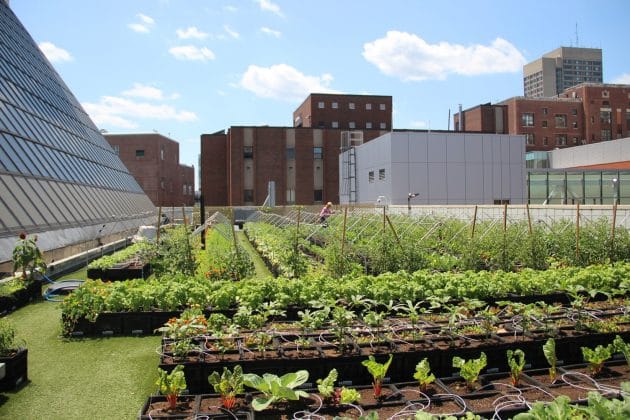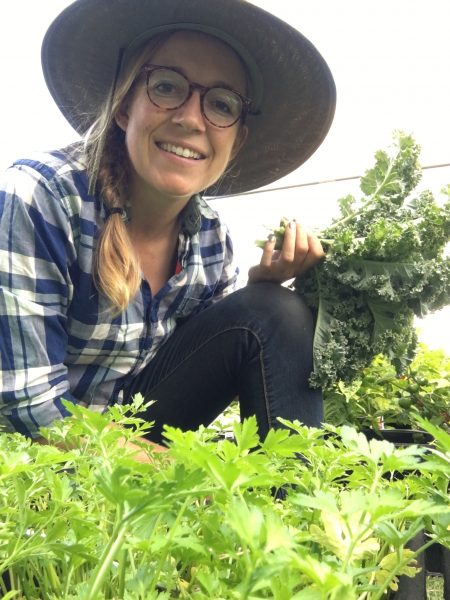Natural Products - Oct 27, 2019 - Michael Wale
A Boston hospital is growing 7,000 pounds of organic vegetables on its rooftop farm as part of its mission to show that food really is medicine, writes Michael Wale.
David Maffeo, senior director of support services was one of the people behind the rooftop farm idea at Boston’s Medical Centre (BMC) in Massachusetts; It is known as a ‘safety-net’ hospital because it mainly serves lower income and elderly patients.
He says: “ I was sitting with my boss and we were talking about the Preventative Food Pantry, a scheme where we introduce poorer people to good food for free for a certain time. I said wouldn’t it be great to grow organic food for our own patients, as well as supplying The Pantry. All organic. No pesticides.”
“I said wouldn’t it be great to grow organic food for our own patients, as well as supplying The Pantry. All organic. No pesticides”
The plan was agreed by the hospital’s Office of Development, and within just a year and a half the first crops were being sown – and soon afterwards harvested. That was 2017. That first year they produced 5,000 pounds (2,600 kilos) of produce. It has since increased to nearly 7000lb.
The farm was designed and installed by roof top growing specialists in Boston-based green roof design specialist Recover.
Milk crate growing containers
The first challenge was the insufficient strength of the hospital’s
existing roof to hold the amount of soil needed for a successful growing
programme.
The cost to the rebuild the roof was put at $200,000. To fund this crucial part of the project, the hospital made successful approaches to a local philanthropist, so circumventing normal budgetary constraints. Once finished it provided 7,000 square feet of growing space. The next thing needed were containers in which to grow the food. It was decided that milk crates were the best – and most available for the job. Evens so, 2,400 of them were needed. Maffeo admits: “We lent on one of our partners to provide them!”
The hospital has done extensive work around sustainability. Research has shown that the life expectancy of the roof farm can be up to 40 years. Particular attention is given to reducing greenhouse gases. On the roof farm, each milk crate is watered through a hosepipe system that runs separately through a device into each crate. It is a strictly metered system that is designed stop functioning when it detects local rainfall.

The hospital is ambitious about expanding the farm, which as well as producing healthy food crops, also places an important role in teaching media staff about food’s role as a medicine. It’s one of the first things students learn about on arrival.
Changing attitudes to food
Maffeo explains the changing attitudes in America towards food and health: “Food has come a long way in the United States. I’ve worked in a hospital kitchen. Now I only buy fresh fish, locally caught. And I’ll only buy grain-free beef. These are all big changes in our attitude to food, and how it is grown. At the farm here, we grow 25 different types of vegetables and salad produce. Everything from tomatoes to carrots and peppers. There farm also makes honey from beehives, which yield around 150lbs of honey a year.

Lindsey Allan (pictured) is the farm manager, with the job of planting and organising the whole growing process. She went straight to work on a farm when she left High School, and found that she enjoyed it. She says that she has never had any interest in chemicals-based farming, and had a background as a keen organic gardener.
Every farm she was involved in over the years was organic, and she is always acutely aware of climate change. She admits to some initial scepticism about the concept of BMC’s too farm, particularly the because the milk crate containers would not allow development of a normal root system.
But she settled on compost based soil, as composting companies found that living soil was important. It was provided by Vermont Compost, which is organic approved. She explains: “We got all the soil up there, already in the milk crates. It took six hours, and we took it to the second floor in the freight lift, and then volunteers took it to the roof site”.
Demonstrating how tech is is helping to make farming more sustainable, she points out that she controls the watering system from her phone or computer, allowing her switch irrigation on or off remotely.
As for the actual growing of the food, she says: “Most things grow well. You want a continual harvest, things that are in the ground for as little time as possible – pak-choi would be a good example. I don’t do one time harvest crops, like broccoli, cabbage or potatoes. I have to think what I can get out of every square inch. Some crops work better than others. For example, we found that green beans were labour intensive for us and the kitchen. We grow what the chefs want and they are pretty flexible. We can only provide a small amount of the food they are serving. Salad stuff is the most popular, cherry tomatoes, radishes and so on”.
World’s healthiest population ambition
She discusses crop choice and planning with the hospital dieticians, who have encouraged her to grow spinach and kale. She says that now that the farm is up and running, she would love another roof, and suggests this could happen in the coming years as everyone is so happy with the results so far.
Because the growing is confined to milk crates it is not surprising to hear that she uses the no till method adding: “You hands are your power tools. No till means using your hands more. Although she says that gardeners are useful to work with, it really does need a farmer to be in control, because you need a volume of production of food, and you have to set targets for this.
For David David Maffeo, BMC’s organic roof farm forms part of wider, bigger ambitions. These, he says, are nothing short of “making Boston the healthiest population in the world”.
